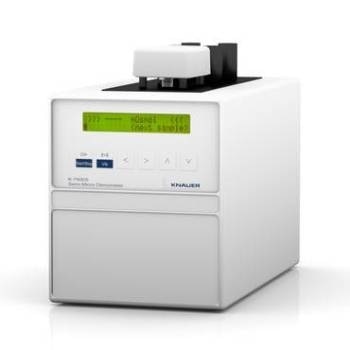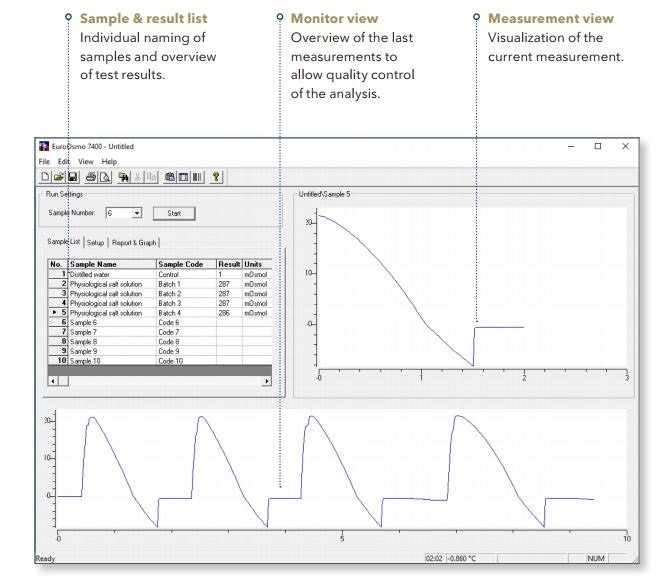One of the most common medical problems in the area of ophthalmology is dry eye syndrome. The eyes usually become dry as a result of external influences such as air travel, air pollution, air conditioning and central heating. This often leads to the tear fluid losing liquid and becoming more concentrated. This article describes a simple and fast technique that can be used to ascertain the osmolarity of salt solutions for the preparation of eye drops.
Osmotic Pressure
Tear fluid has an osmotic pressure (owing to its colloid electrolyte content) that can be measured using the Pepper's cell technique. However, this technique is complicated and time consuming.
The osmotic pressure is a colligative property and can be determined by quantifying the freezing point, which is relative to the osmotic pressure. A freezing point osmometer is used to determine the osmotic pressure and can be specified as osmolarity in mOsmol per liter (mOsmol/l).
In ophthalmic samples from healthy subjects, the tear film usually varies from 290 to 300m Osmol/l. As the osmolarity increases, the liquid content decreases. A severe decrease of the liquid content in tear fluid can permanently damage the eye.
In many publications, the following classification and limits can be found:
- Values less than 308mOsmol/l are considered normal
- Values between 308–328mOsmol/l represent the range for mild to moderate dry eye
- Values higher than 328mOsmol/l indicate serious illness
Hypotonic/Hypertonic Solution
A hypotonic or hypertonic solution can cause eye pain. The tonicity tolerance range in the eye varies from 0.7 to 1.4% NaCl solution and no pain is to be expected within these limits. Hence, it is vital to check the solutions’ osmolarity with a freezing point osmometer.
Irritation can occur if eye drops are applied with different tonocity. Hypertonic solutions have a greater tolerance range, as these are diluted by the tear fluid.
On the other hand, hypotonic eye drops should be made isotonic so that the solution contains the same number of osmotic active particles as the tear fluids. NaCl is commonly used as an isotonization additive.
Method Parameters and Sample Preparation

Figure 1. KNAUER semi-micro osmometer K-7400S
For the experimental analysis, the following apparatus and parameters are used:
- Instrument: KNAUER semi-micro osmometer K-7400S
- Sample tubes: Glass vials
- Sample volume: 150µl
- Measurement view (min): 3.0
- Monitoring view (min): 3.0
- Cooling limit (°C): -12.0
- Freezing level (°C): -5.5
- Units: mOsmol
Figure 1 shows the KNAUER semi-micro osmometer K-7400S. Deionized water (consistent with the 0mOsmol point) and a 300 mOsmol/l calibration standard (consistent with the 300 mOsmol point) are used for a two-point calibration. In this context, the predicted measurement values will be greater than 300 mOsmol/l.
Two samples are prepared for the experiment. For the first sample, 0.9g of NaCl was dissolved in 100ml of deionized water and filtered via a 0.45 micron filter. A standard eye drop solution is used as the second sample. Both samples can be quantified directly following calibration of the osmometer.
Experimental Procedure
First, a 0.150 ml sample or calibration solution is placed into a clean, dry measurement vial, which is placed into the adapter. Care must be taken to ensure that the meniscus of the liquid is horizontal. The measuring head on the instrument is placed in such a way that the vial extends into the cooling cavity, at which point the instrument is ready for calibration or measurement.
Then, the start key on the instrument or the start button in the software is pressed. After finishing the run, the measurement vial is carefully removed from the thermistor.
Table 1. Result table generated by EuroOsmo 7400S software.

The instrument calibration displays a <1% measurement error for the acquisition of data, as shown in Table 2, corresponding to the device policy for the KNAUER osmometer . Following effective instrument calibration, the determination of the samples’ freezing points can be carried out analogously. The data acquisition can also be performed using the EuroOsmo 7400S software.
Table 2. Data of the sample measurements
|
|
Osmolarity of a 0.9% sodium chloride solution (mOsmol/l)
|
Osmolarity of eye drops from the pharmacy (mOsmol/l)
|
|
Measurement 1
|
290
|
308
|
|
Measurement 2
|
289
|
310
|
|
Measurement 3
|
290
|
310
|
|
Measurement 4
|
291
|
309
|
|
Measurement 5
|
289
|
308
|
|
Measurement 6
|
290
|
308
|
|
Mean value
|
289.83
|
308.83
|
|
Measurement error
|
0.33%
|
0.33%
|
Results and Discussion
The six measurements of osmolarity values for the 0.9% NaCl solution provided a mean value of 290 mOsmol/l (Table 2). As the tear fluid exhibits an osmolarity of 290–300 mOsmol/l, the quantified NaCl solution can be regarded isotonic.
Following multiple determination, the standard eye drops provided an average reading of 309 mOsmol/l. Therefore, the eye drops can be considered slightly hypertonic. When the eye drops are used, the tear fluid dilutes the solution and the osmolarity reduces, leading to an isotonic range in the eye. The reproducibility and precision are well within the acceptable levels of 1%. This shows how accurate the device is in its operation.
Conclusion
This simple and fast method of determining the osmolarity of salt solutions is commonly used in the production of eye drops. Depending on the measured osmolarity value, NaCl can be added to a hypotonic solution to make it isotonic, while water can be added to a hypertonic solution. Using KNAUER semi-micro osmometer K-7400S , the determination of the osmolarity of eye drops is made quick, simple, and accurate.
About KNAUER
 KNAUER is an owner-managed middle-sized company with more than 120 employees situated in Berlin, Germany. Since 1962, KNAUER has been producing and developing high performance liquid chromatography (HPLC) systems. The HPLC technique is used to separate, identify and quantify substances in a mixture. It can be used for many applications, including the analysis of toxics in drinking water, the detection of drugs in blood as well as for the purification or quality inspection of pharmaceutical and chemical products.
KNAUER is an owner-managed middle-sized company with more than 120 employees situated in Berlin, Germany. Since 1962, KNAUER has been producing and developing high performance liquid chromatography (HPLC) systems. The HPLC technique is used to separate, identify and quantify substances in a mixture. It can be used for many applications, including the analysis of toxics in drinking water, the detection of drugs in blood as well as for the purification or quality inspection of pharmaceutical and chemical products.
Sponsored Content Policy: News-Medical.net publishes articles and related content that may be derived from sources where we have existing commercial relationships, provided such content adds value to the core editorial ethos of News-Medical.Net which is to educate and inform site visitors interested in medical research, science, medical devices and treatments.